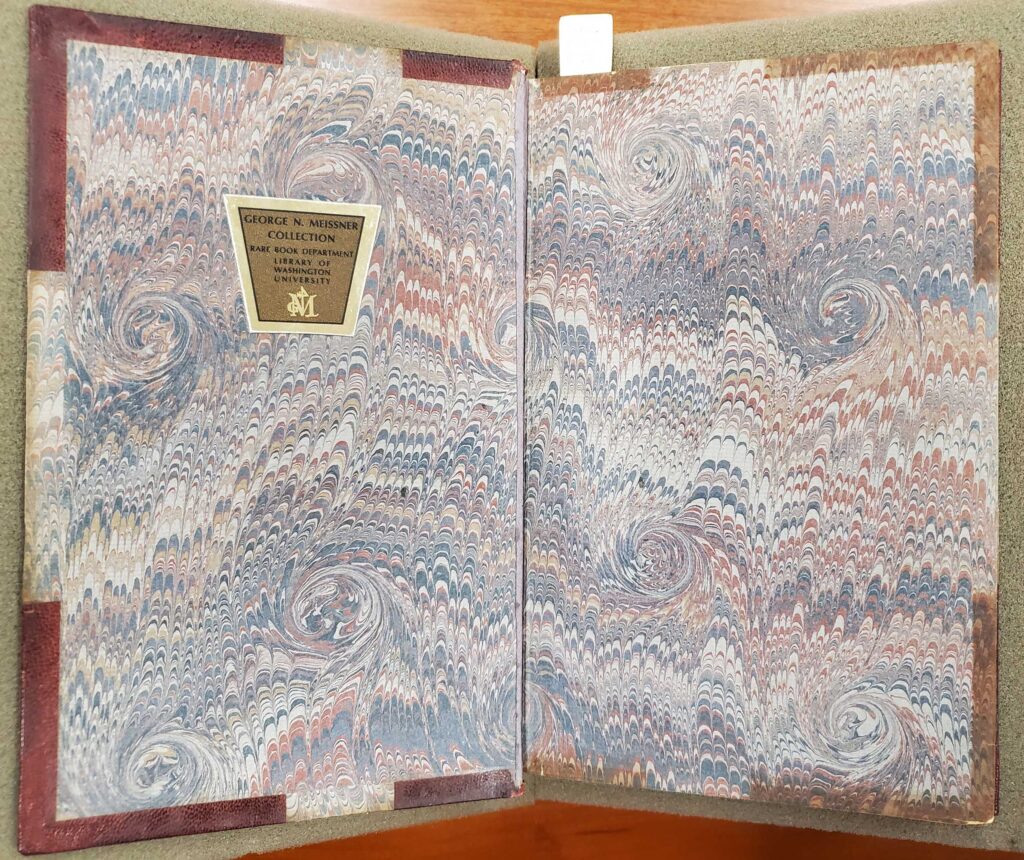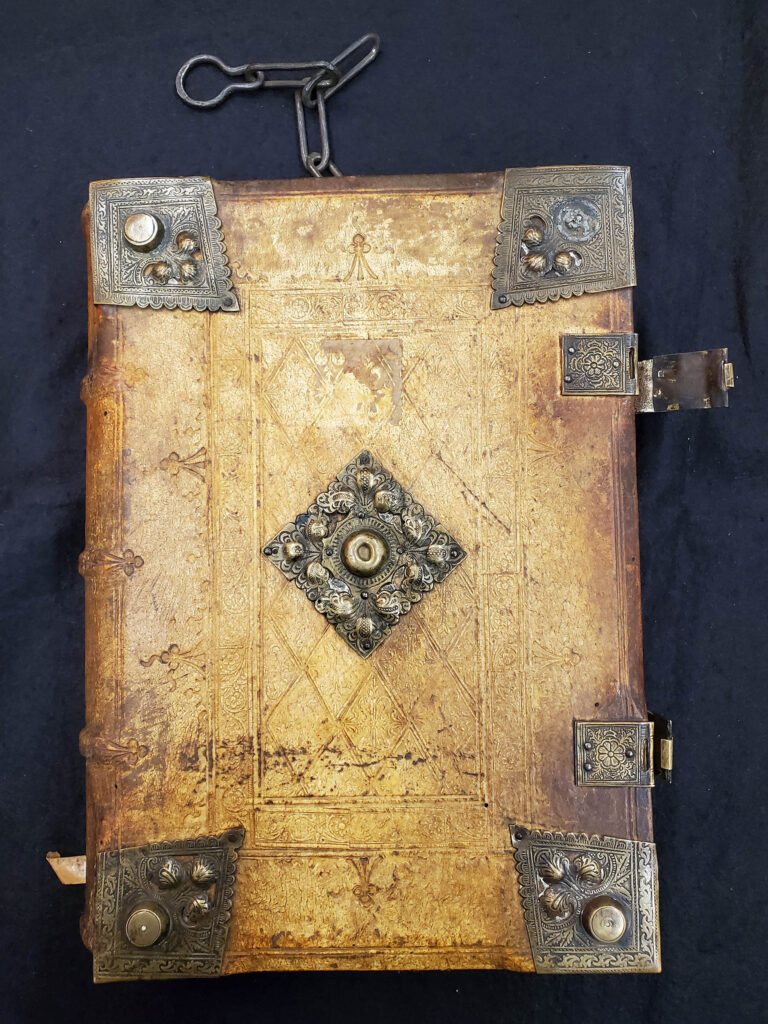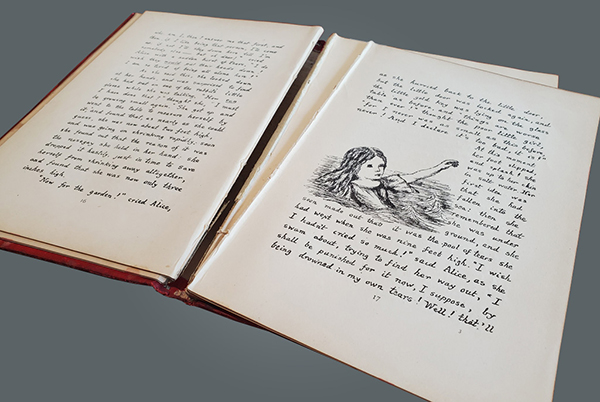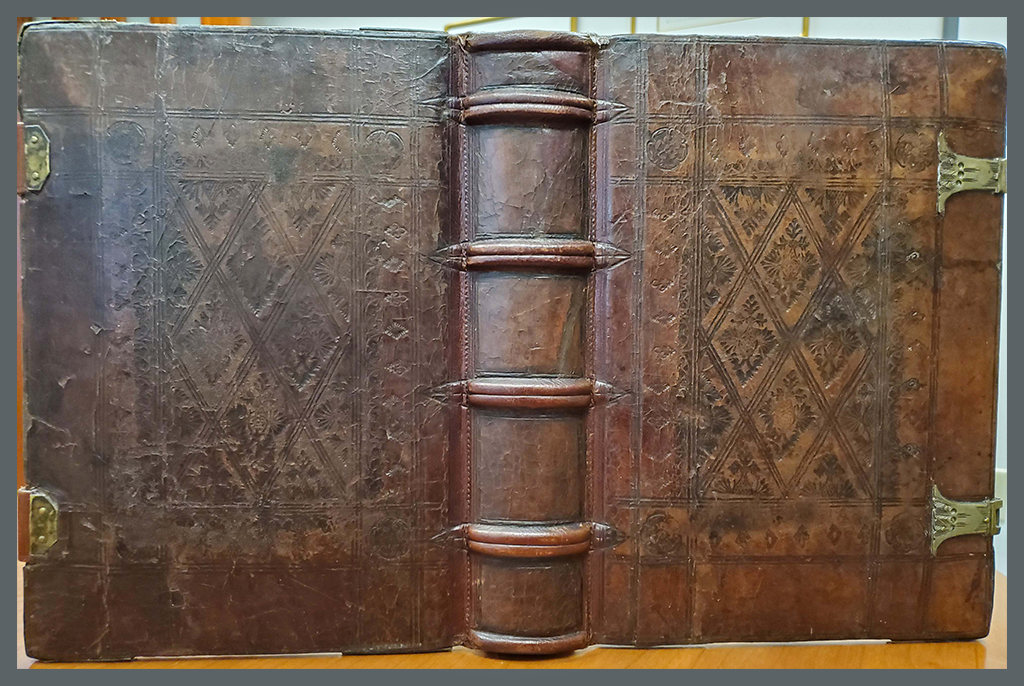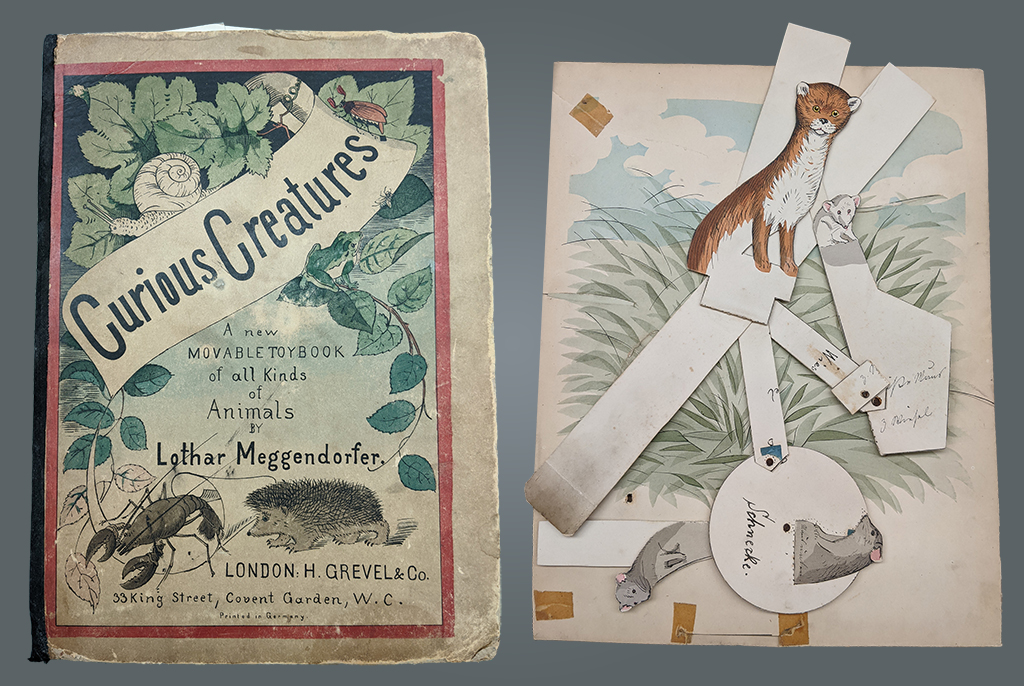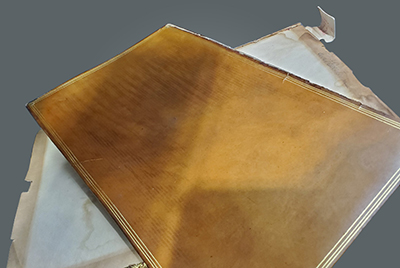Legacy of Books Wishlist

Imagine that the written record of human thought and endeavor was slowly disintegrating, eventually becoming unreadable. Today Washington University Libraries face that daunting dilemma, as age and use take a steady toll on our collections.
Help us preserve our past and protect our future by giving to the Libraries’ Legacy of Books program. A tax-deductible gift of $100 or more covers the cost of preserving one library book or an item in another format. Larger gifts cover multiple items or more costly conservation projects such as those described below.
Please contact Rebecca Wagner in University Libraries Advancement with questions about making a gift. If the conservation project you are interested in is already funded, she would be happy to connect you with Special Collections staff to discuss additional preservation opportunities based on your interests.
Current Wishlist
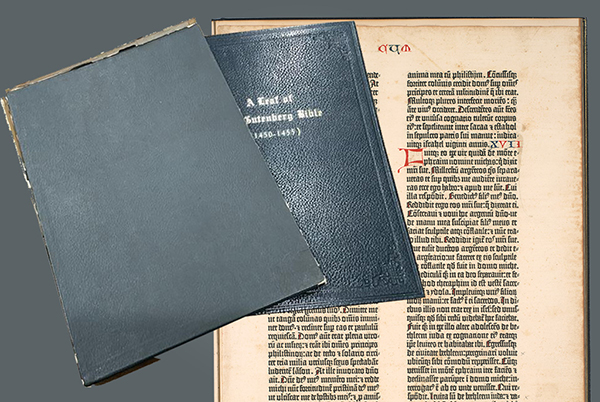
A Noble Fragment: Being a Leaf of the Gutenberg Bible, 1450-1455
A Noble Fragment is the title of two copies of a book that each contain a single leaf from an original Gutenberg Bible, the first book printed with movable type in the West. Though the books themselves are in excellent condition, their original protective slipcases produced in 1921 are beginning to come apart at the seams. Custom archival boxes will be crafted to continue to protect the books, with a small drawer to also protect and keep the slipcase.
Conservation Estimate: $300 for each of the two custom archival enclosures
Ella Hough’s sketches (from Elizabeth Ellen Hough Papers WUA00556)
Ella Hough created sketches of portraits, landscapes, and animals as an art student at Washington University from 1888 to 1890. This is the only student-original artwork that the University Archives has from this time period. More information about Ella can be found at the donor’s blog: Phyllis Wheeler Blog: Ella Hough, full of promise.
Ella’s family kept these sketchbooks safe for over 130 years, though some preservation work is needed in order to make them stable for researchers to use. The large-format, loose sketches will be non-aqueously deacidified, flattened, and mended as needed before being carefully matted and housed in an archival enclosure. The small sketchbook will be resewn, and the binding will be repaired to allow for research use.
Conservation Estimate: $500 for each of the two projects
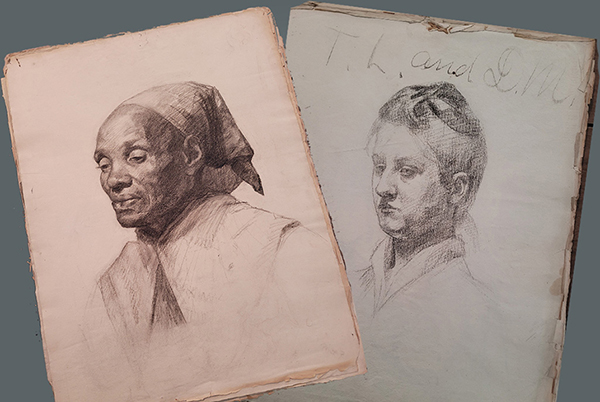
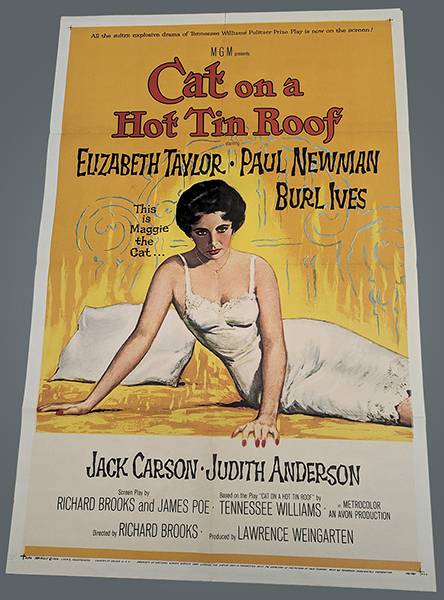
Cat on a Hot Tin Roof Movie Poster, 1958 (from Tennessee Williams Collection MS00134)
Like much of the ephemera from Hollywood of this period, this vibrant movie poster was printed on acidic paper and is now extremely fragile. Currently stored folded, every use of the item splits the folds of the paper open, causing further damage. This item will be non-aqueously deacidified, flattened, and mended as necessary, then encapsulated in clear mylar to support its fragile paper and allow it to be stored flat between usages.
Conservation Estimate: $500
Views from St. Louis water works by Clinton Kimball, 1892
A unique collection of 102 cyanotypes taken as part of the author’s classwork in Civil Engineering at Washington University in St. Louis. The cyanotypes were glued into an album created by a local St. Louis bookbinder of the time. The images date from 1889 to 1892 and include the construction of Merchants Bridge, riverfront scenes, and the Cotter Dam.
The album’s spine and boards have become loose and detached from the pages. The pages themselves are cockled from the adhesive used to adhere the photos, making digitization of these images difficult. The volume is to be carefully disbound, and pages flattened for digitization before being rebound in the repaired original album’s case.
Conservation Estimate: $1,000
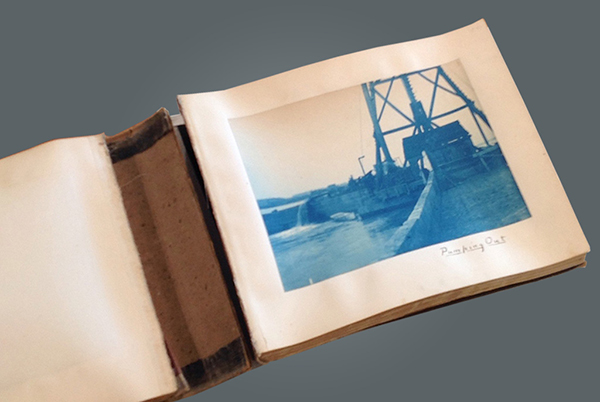
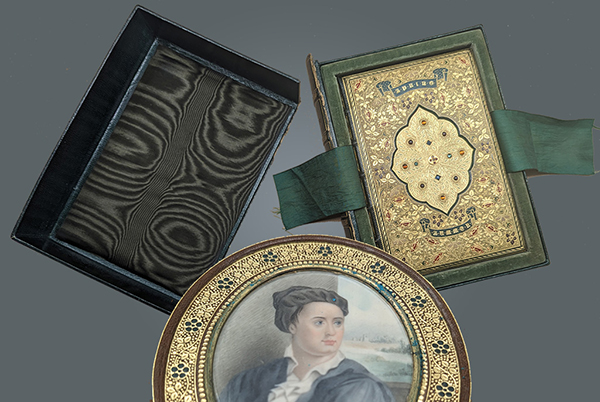
The Seasons; and, The Castle of indolence by James Thomson, 1841
This beautiful jeweled book was bound during a period when mass-produced books often came with a standard edition binding. The juxtaposition of the mass-produced text with the hand-crafted binding gives an important look at the tensions between mass production and handicraft created by the Industrial Revolution. The metals used to adorn the inner front cover have corroded and will be cleaned to prevent further damage to the volume. The original box, almost as much of an artwork as the binding itself, has sustained significant damage while protecting the book and will be repaired to continue protecting its contents.
Conservation Estimate: $2,000
Heures a l’usage de Rome (Book of Hours), 1450
Most of the books of hours—illuminated manuscripts used for daily devotion—in our collection have been rebound in much later bindings, but this velvet binding may be original to the book. While velvet makes a beautiful cover, it lacks the sturdiness of leather. We are rarely able to use this book because the binding is so fragile. This volume’s binding will be repaired such that all fragments that remain of the velvet spine will be retained, and the structure itself will be strengthened to hold up to careful usage.
Conservation Estimate: $3,200
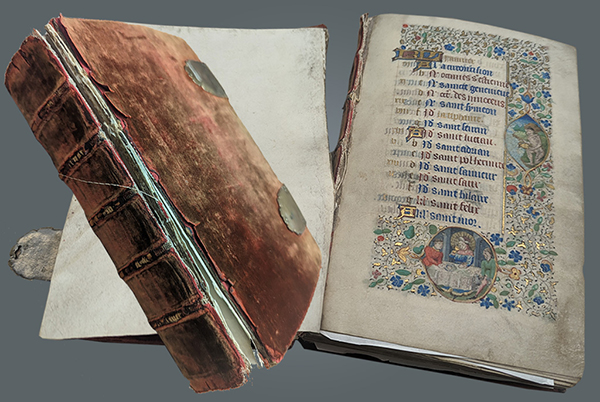
Funded Projects
The following wishlist items have benefitted from the support of our donors. Past contributions have allowed the conservation and preservation of these former wishlist materials, enabling researchers and students alike to continue studying them well into the future.
Visit our Preservation page for more information on how items within the Washington University Libraries are kept and maintained.
H. M. Brackenridge, Views of Louisiana, 1814
In this work, Brackenridge, a lawyer and journalist who moved to Missouri in 1810, records details of his journey up the Missouri River, along with information about the history and geography of the area. Both covers of the volume were detached.
Conserved with a gift from Laura Epstein Shindler, LA68 and Donald A. Shindler, BU68.
Angelo Carletti, Summa Angelica, 1488
At a time when books were considered precious objects, bindings sometimes included chains to prevent theft or loss. This beautifully preserved example of a chained binding required a custom-made case that provided additional protection and prevented the metal attachments from damaging neighboring volumes on the shelf. The text of this incunable, or book printed before 1501, is by the 15th century Franciscan Angelo Carletti, a writer on canon and civil law.
Lewis Carroll, Alice’s Adventures Underground, 1886
This beautiful facsimile of Lewis Carroll’s original manuscript, including 37 illustrations drawn by him, needs work to stabilize the text block. A gathering of pages has separated from the rest, and many others are loose. The binding has split and is in need of cleaning.
This work was conserved with a gift from Lester Reingold, LA73, and Sue Reingold in honor of the 50th wedding anniversary of Debbie Colodny, LA73, and Chuck Colodny, LA73.
Horace, Opera cum Commentariis, 1516
Bindings produced early in the 16th century are somewhat scarce. This fine example of tooled leather covering wooden boards was probably executed shortly after this critical edition of Horace appeared in 1516. The front board had split along the wood grain and torn the leather at the break.
Conserved with a gift from Jef and Kathy Missman in honor of Vice Chancellor Shirley K. Baker.
Lothar Meggendorfer, Curious Creatures, 1890
Curious Creatures adds adorability through the ability to make the creatures move. The creator of this book, Lothar Meggendorfer, is famous for designing early moveable books for children in late 19th century Germany. Movable books are especially fragile, and those created for children are often used to death, so it is amazing that this book survived!
Curious Creatures was conserved with a gift from Lester Reingold, LA73, and Sue Reingold in honor of the 50th wedding anniversary of Debbie Colodny, LA73, and Chuck Colodny, LA73. Many of the mechanisms that allowed the animals in Curious Creatures to move had broken. A trained conservator was needed to mend the broken pieces.
Optique no. 4 : Promenade de Longchamp, ca., 1827 (aka peepshow)
This early example of a peep show forms part of the Libraries’ Henrietta Hochschild Collection of Children’s Books. The structure consists of a series of illustrated cut-outs connected by paper hinges to create a three-dimensional scene viewed through the opening at the center. Many of the hinges in this copy were weakened or split through use by previous owners, making the item vulnerable to further deterioration.
Conserved with a gift from Anne and David Bromer in honor of Julian I. Edison.
Edgar Allan Poe, Mesmerism “in Articulo Mortis,” 1846
Poe’s interest in mesmerism (or hypnotism) is seen in this literary work, which he wrote in the style of a scientific text. This volume was heavily damaged by water, which caused the boards to warp and become detached. This volume received significant work to stabilize and repair the binding.
This work was conserved with a gift from Daniel J. Smith (BA ’85) and Linda Way-Smith.
Edgar Allan Poe, The Raven, and Other Poems, 1845
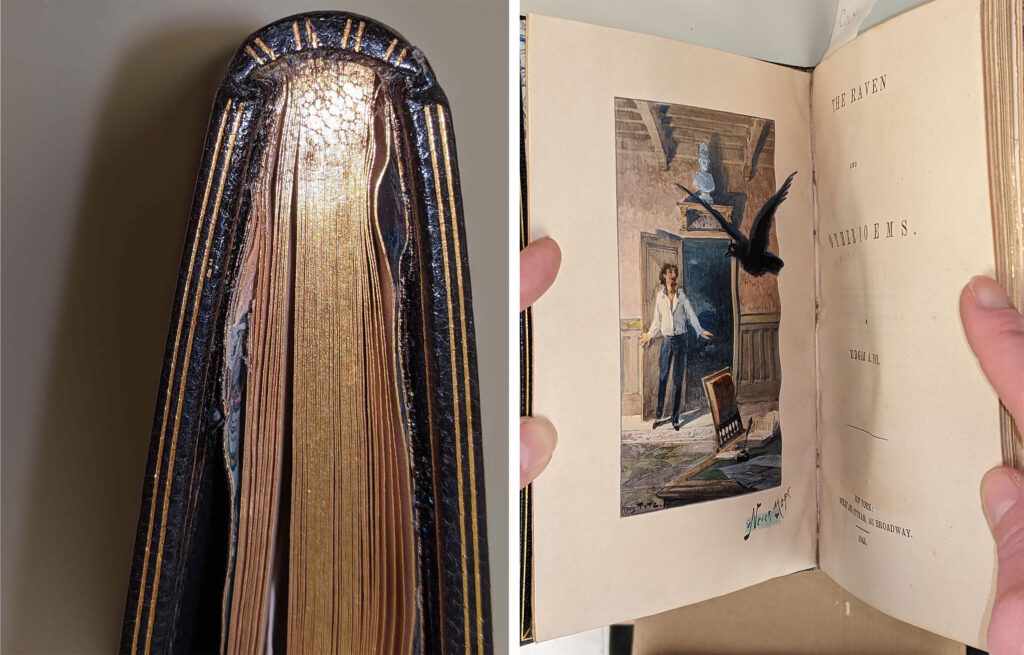
This first edition of The Raven, with its gorgeous designer binding, had severe water damage. The water damage had tightened the binding and warped the boards so that the book could only be opened slightly, barely enough to see the original watercolor by Titz added before the title page.
Thankfully, the water had not damaged the text or watercolor. Funds were used to restore the binding to working conditions so scholars, students, and the community could enjoy this book.
This work was conserved with a gift from Daniel J. Smith (BA ’85) and Linda Way-Smith.
